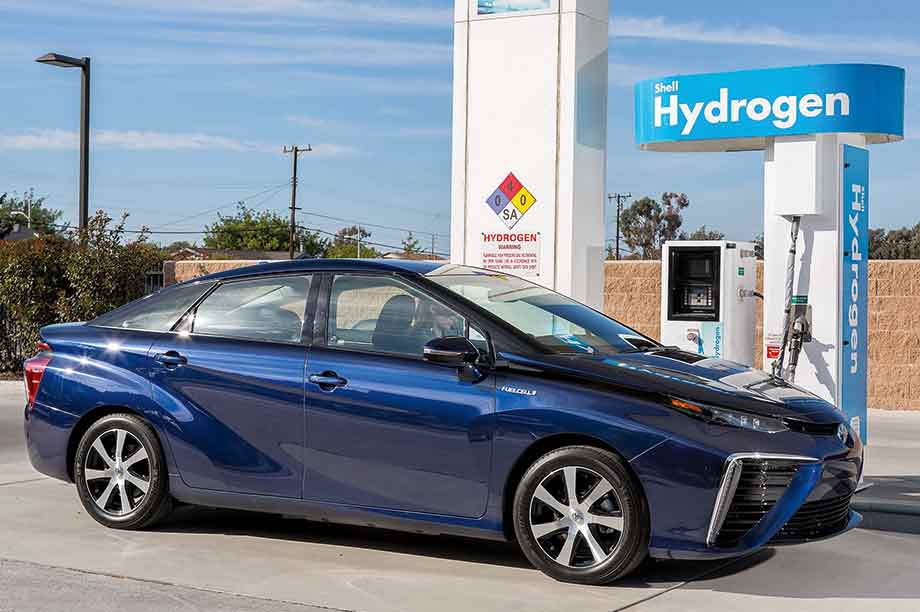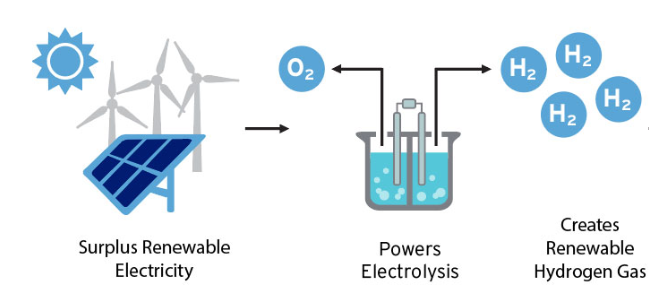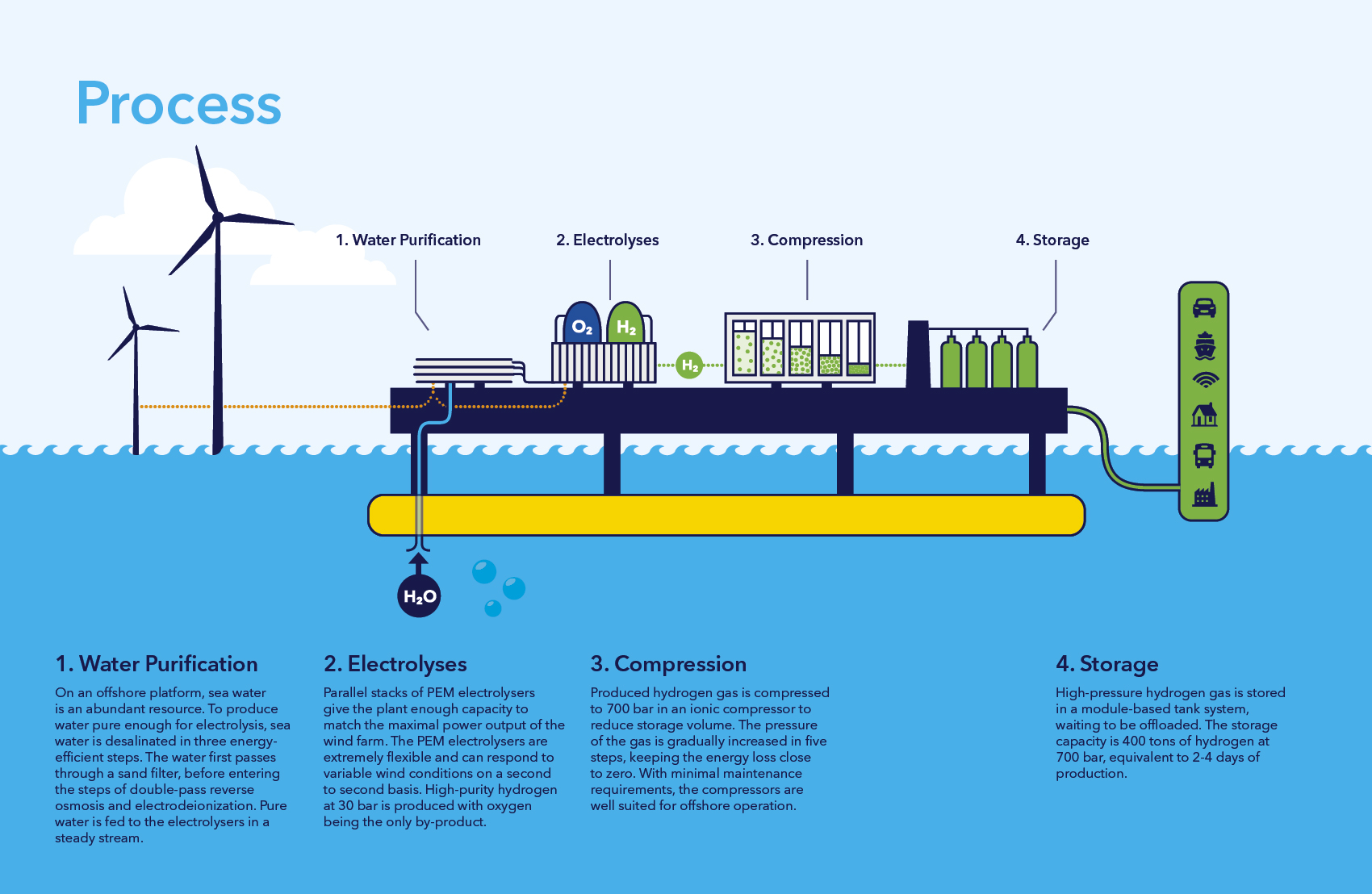
The wind power to produce hydrogen
Recently, Shell, Siemens and TenneT jointly called on the German government to accelerate the technical research on the use of offshore wind power to produce hydrogen, and suggested that consideration be given to tendering for offshore wind power hydrogen production projects to effectively alleviate the contradiction between the rapid growth of offshore wind power and the slower speed of grid construction. Thereby promoting the development of German offshore wind power.

Key point
Global offshore wind power looks at Europe. In addition to Europe, the “leader,” Britain, Germany’s offshore wind power development momentum should not be underestimated. They actively deployed offshore wind power in the Baltic and North Sea economic belts. After several rounds of offshore wind power bidding, by the first half of 2018, Germany’s total offshore wind power installed capacity reached 5355MW, closely following the number one in the UK.
However, behind the rapid development will also be accompanied by the same dilemma faced by the wind power industry in various countries. Even Germany, which has always been known for scientific planning and rigor, cannot escape, that is, the lagging grid construction speed cannot meet the rapid expansion of offshore wind power delivery. Needed. As long as the project is located in the North Sea, it will be more or less affected by the power grid restriction, which is mainly limited by the grid capacity. Objectively speaking, the original intention of Germany to develop offshore wind power will not change, but the construction of the offshore transmission system requires a large amount of preliminary planning, surveying, and approval. The construction period is longer and requires the cooperation of all parties.

Breaking
Direct hydrogen production from offshore wind power avoids the difficulties of power system construction and provides a feasible idea for the development of offshore wind power. That’s why the above companies have called for accelerated development of offshore wind power hydrogen production projects, and suggested that the German government consider conducting tenders for offshore wind power hydrogen production projects.
The three companies that raised the questions were representative companies in the oil and gas industry, offshore wind power industry, and power transmission industry. These companies believe that the implementation of bidding for projects that combine offshore wind power with hydrogen production technology will promote the development of offshore wind power and renewable energy power in Germany and achieve the goals of the German climate agreement. The use of this type of hybrid power project will allow Germany to build more offshore wind power without burdening the onshore power grid, which will help alleviate the long-term problem of German offshore wind power development due to grid connection issues.
Hydrogen production mode of offshore wind power

This model is based on a research project called “Power to Gas” by E-bridge, which uses electricity to generate hydrogen and oxygen to balance the power supply and demand relationship in the power grid. To put it simply, hydrogen storage to regulate the peaks and valleys of electricity is another technical route of energy storage technology.
“Power to Gas” uses offshore wind power to produce hydrogen on-site, and then transports the hydrogen back to land for power generation and transportation fuel, thereby reducing dependence on the transmission network; it can also be combined with the use of oil and gas companies’ pipelines to convert new energy Combine power generation with the resources of the original gas manufacturers to achieve carbon reduction goals and improve environmental acceptance.
The advantages of this model are obvious:
New offshore wind power projects do not need to build new offshore power transmission systems and are not restricted by grid companies;
Offshore wind power can be built nearby oil and gas platforms or oil and gas pipelines, reducing transmission losses and possibly reducing project investment costs;
Offshore wind power is rich in raw materials for hydrogen and oxygen production, and offshore can be said to be “inexhaustible”.
Environmentally friendly, both natural gas and petroleum are carbon-containing fossil energy sources, and the product of hydrogen combustion is still water, which truly achieves zero emissions.
How to do next
Although the idea is good, further research is needed on the development of this model, including offshore hydrogen production technology, hydrogen storage technology, environmental issues and the safe coexistence of gas platforms. In addition, the business model also needs further research.
Therefore, the three companies are currently actively researching, and at the same time, it is recommended that the German government carry out research on the bidding model of offshore wind power and hydrogen generation projects to cul
Recently, Shell, Siemens and TenneT jointly called on the German government to accelerate the technical research on the use of offshore wind power to produce hydrogen, and suggested that consideration be given to tendering for offshore wind power hydrogen production projects to effectively alleviate the contradiction between the rapid growth of offshore wind power and the slower speed of grid construction. Thereby promoting the development of German offshore wind power.

Key point
Global offshore wind power looks at Europe. In addition to Europe, the “leader,” Britain, Germany’s offshore wind power development momentum should not be underestimated. They actively deployed offshore wind power in the Baltic and North Sea economic belts. After several rounds of offshore wind power bidding, by the first half of 2018, Germany’s total offshore wind power installed capacity reached 5355MW, closely following the number one in the UK.
However, behind the rapid development will also be accompanied by the same dilemma faced by the wind power industry in various countries. Even Germany, which has always been known for scientific planning and rigor, cannot escape, that is, the lagging grid construction speed cannot meet the rapid expansion of offshore wind power delivery. Needed. As long as the project is located in the North Sea, it will be more or less affected by the power grid restriction, which is mainly limited by the grid capacity. Objectively speaking, the original intention of Germany to develop offshore wind power will not change, but the construction of the offshore transmission system requires a large amount of preliminary planning, surveying, and approval. The construction period is longer and requires the cooperation of all parties.

Breaking
Direct hydrogen production from offshore wind power avoids the difficulties of power system construction and provides a feasible idea for the development of offshore wind power. That’s why the above companies have called for accelerated development of offshore wind power hydrogen production projects, and suggested that the German government consider conducting tenders for offshore wind power hydrogen production projects.
The three companies that raised the questions were representative companies in the oil and gas industry, offshore wind power industry, and power transmission industry. These companies believe that the implementation of bidding for projects that combine offshore wind power with hydrogen production technology will promote the development of offshore wind power and renewable energy power in Germany and achieve the goals of the German climate agreement. The use of this type of hybrid power project will allow Germany to build more offshore wind power without burdening the onshore power grid, which will help alleviate the long-term problem of German offshore wind power development due to grid connection issues.
Hydrogen production mode of offshore wind power

This model is based on a research project called “Power to Gas” by E-bridge, which uses electricity to generate hydrogen and oxygen to balance the power supply and demand relationship in the power grid. To put it simply, hydrogen storage to regulate the peaks and valleys of electricity is another technical route of energy storage technology.
“Power to Gas” uses offshore wind power to produce hydrogen on-site, and then transports the hydrogen back to land for power generation and transportation fuel, thereby reducing dependence on the transmission network; it can also be combined with the use of oil and gas companies’ pipelines to convert new energy Combine power generation with the resources of the original gas manufacturers to achieve carbon reduction goals and improve environmental acceptance.
The advantages of this model are obvious:
New offshore wind power projects do not need to build new offshore power transmission systems and are not restricted by grid companies;
Offshore wind power can be built nearby oil and gas platforms or oil and gas pipelines, reducing transmission losses and possibly reducing project investment costs;
Offshore wind power is rich in raw materials for hydrogen and oxygen production, and offshore can be said to be “inexhaustible”.
Environmentally friendly, both natural gas and petroleum are carbon-containing fossil energy sources, and the product of hydrogen combustion is still water, which truly achieves zero emissions.
How to do next
Although the idea is good, further research is needed on the development of this model, including offshore hydrogen production technology, hydrogen storage technology, environmental issues and the safe coexistence of gas platforms. In addition, the business model also needs further research.
Therefore, the three companies are currently actively researching, and at the same time, it is recommended that the German government carry out research on the bidding model of offshore wind power and hydrogen generation projects to cul




